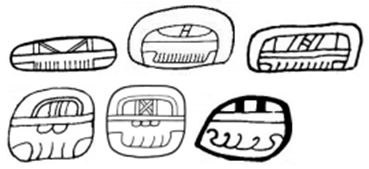

![]()
![]()
K&H.p21 = K&H.p81.#1 TOK.p12.r5.c1 BMM9.p11.r5.c1 JM.p49.#3
CHAN CHAN CHAN CHAN:na

K&L.p10.#2
CHAN




K&L.p15.#2.1&2&3 TOK.p27.r1.c4 BMM9.p19.r2.c4 JM.p49.#4
CHAN CHAN / WINIK.HAAB CHAN CHAN


MC.p82.pdfp83.r47.c1 = Zender-BH.p9.fig7 = M&G.p206.1
K’AHK.<HOP:po> <la:ja>.<CHAN:na> K’AWIIL[la]
· The alternation chan vs. kan is often spoken about as the non-Yucatec vs. Yucatec pronunciations for “snake”.
· It also applies to “sky” (and probably also “four”), but we see it most often in the polity KAAN, where they found it very important to stress that it’s the k- pronunciation; it’s less important for “sky” and ‘visually’ more difficult of “four”.
· The na which is often written after CHAN is always just a phonetic complement, never an underspelling for -na{l} – when a -nal is intended, it will be written with the NAL (“corncob”); this applies both in the meaning of “place” as well as for the adjectival ending for “celestial” (doubly confirmed by Dorota Bojkowska).
· Variants (2):
o A. Boulder outline – features:
§ Top:
· Bold ceiling.
· Two vertical non-touching bars from the ceiling to the floor.
· Crossed bands between the vertical bars (canonical, but can be single diagonal bar or 1 (bold) rung bold ladder etc).
§ Middle:
· Divided in half by a horizontal line or bar.
· Hanging from the horizontal line or bar: 2-3 touching dots in the middle.
§ Bottom:
· Lipped-U.
· Grass blades growing on the base of the U.
o B. Bird head – features:
§ Headdress:
· Top: “LEM”.
· Left: Optionally with element sticking out left or cross-hatched oval forehead ornament.
· Right: oval feather / o.
· Bottom: “tassels” – optionally with each tassel ending in a tiny dot.
§ Beak: Optionally, a mouth tendril to the right.
§ Right side: optionally, an oval element, longer in the vertical axis, vaguely resembling a “LEM” with an internal ladder, or an AK’AB or a li.